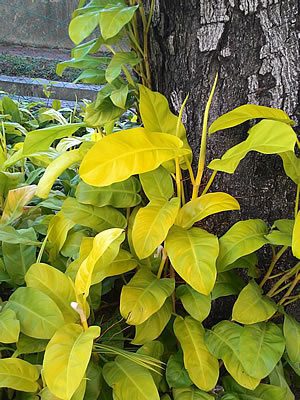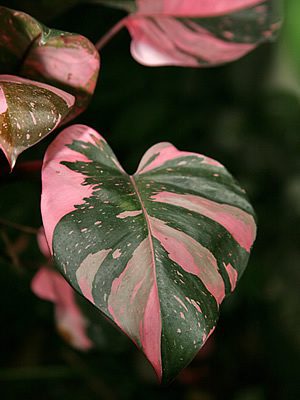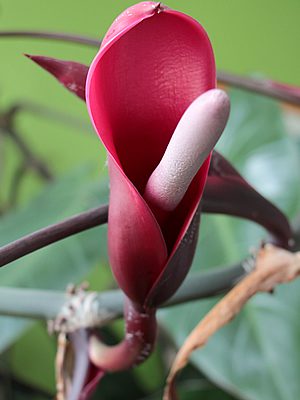The Red-leaf Philodendron (Philodendron erubescens) is a herbaceous, evergreen, and climbing plant native to Colombia, Costa Rica, and Brazil, where it thrives in warm and humid forests, climbing different types of trees. The genus name, Philodendron, originates from the combination of the Greek words Philos, meaning “love,” and Dendron, meaning “tree.” Hence, the union of these words perfectly describes a genus that loves trees, whether growing as climbers or epiphytes. The specific epithet, erubescens, also comes from Greek and refers to the reddish color of the stems, inflorescences, and new shoots of this species.

A very robust climber with a herbaceous yet thick stem, it attaches to the rough bark of trees using adventitious roots. This way, it finds support to grow for many feet (reaching heights of up to 59 feet!), although the average height of individuals found in nature is about 11.8 feet. The leaves of the Red-leaf Philodendron are arrow-shaped, leathery, glossy, petiolate, with a well-defined straight central vein, and measure 7.9-15.7 inches in length.
In the typical form, they are dark green with a coppery underside. However, philodendrons exhibit considerable variability, and it’s possible to find plants in nature with leaves ranging from green to deep red. Moreover, there are numerous cultivars, displaying everything from intense lime green (P. erubescens ‘Gold’) and deep wine-red (P. erubescens ‘Royal Queen’) to variegations revealing beautiful pink (P. erubescens ‘Pink Princess’). New leaves emerge from within protective sheaths known as cataphylls.

It rarely flowers, and its inflorescences hold little ornamental significance. They are typical of the Araceae family, meaning they are spadix-type, with densely arranged flowers of both sexes on a thickened rachis, accompanied in this case by a beautiful red-wine bract called a spathe. Any fruits that might appear, if the plant is pollinated, are of the berry type.
The Red-leaf Philodendron brings stunning foliage indoors. Its light requirements allow for a tropical effect in indoor spaces that receive only diffuse light from windows or skylights. Moreover, it’s a very hardy plant, resistant to pests and diseases, and doesn’t demand special care. While pruning isn’t necessary, it’s advisable to remove old leaves to keep it beautiful and vibrant. If it outgrows its space, you can control its size through pruning and create new plants from the removed branches. When planting in pots or containers, provide support for the plant to climb, such as a dried tree trunk (with bark intact) or even a pressed coconut fiber pole. In gardens, it can be utilized in flowerbeds protected by trees or shrubs, in semi-shaded and humid areas.

It should be cultivated under filtered light or partial shade, receiving only morning sun. The substrate should be kept consistently moist, well-draining, and airy. Avoid using regular soil for its cultivation. Mixtures containing charcoal, pine bark, coconut coir, perlite, and high-quality organic compost usually work well. Don’t let the Red-leaf Philodendron’s soil dry out between waterings, as it requires constant humidity. On the other hand, it’s also sensitive to overwatering, which can lead to root rot.
The Red-leaf Philodendron originates from tropical forests and appreciates warmth and high humidity. Indoors, supplement humidity with humidifiers if needed. It doesn’t tolerate intense cold, frost, or drought, so during adverse conditions, keep the plant in a protected environment. Remove dust from the leaves occasionally by giving it a shower in the rain or under the shower. Fertilize during the warmer months using organic or slow-release fertilizers. Repot annually to refresh the substrate. Propagation is easy through cuttings, which can root all year round in warm climates or in spring in regions with winter cold. Cuttings can root in prepared, consistently moist substrate or in water-filled jars, with water changed frequently.

